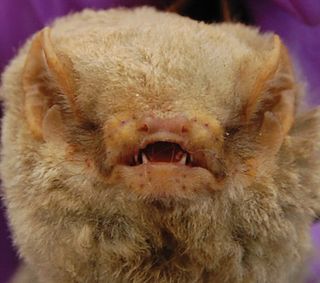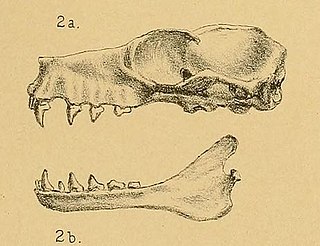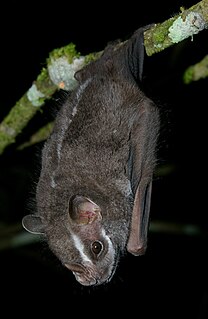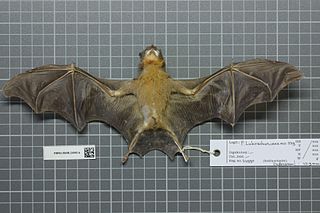 W
WThe Australian myotis is a species of vesper bat. It is found only in Australia. This taxa may not represent a valid species. Only one specimen has ever been documented, supposedly from New South Wales. This specimen may have been mislabelled or a vagrant Myotis muricola or Myotis ater.
 W
WThe bidentate yellow-eared bat is a species of bat in the family Phyllostomidae, native to South America. Formerly classified in the Vampyressa genus, phylogenetic analyses support its inclusion in Vampyriscus.
 W
WThe Burmese whiskered bat is a species of vesper bat. It is found in China, India, Laos, Malaysia, Myanmar, and Thailand.
 W
WChaerephon is a genus of Old World free-tailed bats in the family Molossidae. Molecular sequence data indicates that Chaerephon, Mops and Tadarida are not monophyletic taxa. The closest relatives of Chaerephon jobimena of Madagascar are Tadarida aegyptiaca of Africa and southwest Asia, and Tadarida brasiliensis of the Americas, which form a clade believed to be about 9.8 million years old. However, the grouping of Chaerephon minus C. jobimena plus Mops was found to be monophyletic.
 W
WThe common thick-thumbed bat is a species of vesper bat found in Brunei, Indonesia, Malaysia, Myanmar, Philippines, and Thailand. It has two subspecies:G. t. tylopus G. t. batjanus
 W
WDobson's horseshoe bat is a species of bat in the family Rhinolophidae. It is found in China, India, Myanmar, and Thailand.
 W
WThe dusky fruit bat, is a species of bat found in Indonesia and Malaysia.
 W
WEonycteris is a genus of megabats found in Asia. Species within this genus are:Greater nectar bat, Eonycteris major Cave nectar bat, Eonycteris spelaea Philippine dawn bat, Eonycteris robusta
 W
WGlauconycteris is a genus of vespertilionid bats in Africa.
 W
WThe hairy-faced bat is a species of vesper bat.
 W
WThe large-eared slit-faced bat, Nycteris macrotis, is a species of slit-faced bat which lives in forests and savannas throughout Africa. Nycteris vinsoni was once considered a synonym of N. macrotis, but it became recognized as a separate species in 2004. Some, however, still consider N. vinsoni to be a subspecies of N. macrotis, and consider N. macrotis a species complex.
 W
WThe lesser naked-backed fruit bat is a species of megabat in the family Pteropodidae. It is found in Indonesia and Papua New Guinea.
 W
WThe little collared fruit bat is a species of megabat in the family Pteropodidae found in Angola, Cameroon, the Central African Republic, the Republic of the Congo, the Democratic Republic of the Congo, Ivory Coast, Equatorial Guinea, Gabon, Ghana, Guinea, Liberia, Nigeria, Rwanda, Sierra Leone, South Sudan, Togo, and Uganda. Its natural habitats are subtropical or tropical moist lowland forests and moist savanna.
 W
WThe Madeira pipistrelle is a species of vesper bat. It is endemic to Azores, Madeira and the Canary Islands.
 W
WMegabats constitute the family Pteropodidae of the order Chiroptera (bats). They are also called fruit bats, Old World fruit bats, or—especially the genera Acerodon and Pteropus—flying foxes. They are the only member of the superfamily Pteropodoidea, which is one of two superfamilies in the suborder Yinpterochiroptera. Internal divisions of Pteropodidae have varied since subfamilies were first proposed in 1917. From three subfamilies in the 1917 classification, six are now recognized, along with various tribes. As of 2018, 197 species of megabat had been described.
 W
WMelonycteris is a genus of megabat in the family Pteropodidae. Members are found in the Solomon Islands or in the case of the Black-bellied Fruit Bat, in Papua New Guinea.
 W
WMicrobats constitute the suborder Microchiroptera within the order Chiroptera (bats). Bats have long been differentiated into Megachiroptera (megabats) and Microchiroptera, based on their size, the use of echolocation by the Microchiroptera and other features; molecular evidence suggests a somewhat different subdivision, as the microbats have been shown to be a paraphyletic group.
 W
WMiniopterus, known as the bent-winged or long winged bats, is the sole genus of the family Miniopteridae. They are small flying insectivorous mammals, micro-bats of the order Chiroptera, with wings over twice the length of the body. The genus had been placed in its own subfamily among the vespertilionid bats, as Miniopterinae, but is now classified as its own family.
 W
WThe minor epauletted fruit bat is a species of megabat in the family Pteropodidae. It is found in Zambia, Tanzania, Mozambique and Kenya.
 W
WThe little collared fruit bat is a species of megabat in the family Pteropodidae found in Angola, Cameroon, the Central African Republic, the Republic of the Congo, the Democratic Republic of the Congo, Ivory Coast, Equatorial Guinea, Gabon, Ghana, Guinea, Liberia, Nigeria, Rwanda, Sierra Leone, South Sudan, Togo, and Uganda. Its natural habitats are subtropical or tropical moist lowland forests and moist savanna.
 W
WMystacinidae is a family of unusual bats, the New Zealand short-tailed bats. There is one living genus, Mystacina, with two species, one of which is believed to have become extinct in the 1960s. They are medium-sized bats, about 6 centimetres (2.4 in) in length, with grey, velvety fur.
 W
WThe narrow-winged pipistrelle is a species of vesper bat. It can be found in Brunei Darussalam, Indonesia, and Malaysia.
 W
WMyotis nipalensis commonly known as Nepal myotis is a vesper bat of genus Myotis.
 W
WThe northern free-tailed bat is a species of bat in the family Molossidae. It is found in Indonesia and Malaysia.
 W
WRaffray's sheath-tailed bat is a species of sac-winged bat in the family Emballonuridae. It is found in eastern Indonesia, Papua New Guinea, and Solomon Islands.
 W
WThe round-eared tube-nosed bat, is a species of bat in the family Vespertilionidae from Central and Southeast Asia.
 W
WThe rufous trident bat, Persian trident bat, or triple nose-leaf bat is a species of bat in the genus Triaenops. It occurs in southwestern Pakistan, southern Iran, the United Arab Emirates, Oman, and Yemen. In the last country, it occurs together with the much smaller Triaenops parvus. Populations from Madagascar and mainland Africa have also been assigned to T. persicus, but are referable to the species Triaenops menamena and Triaenops afer, respectively. Madagascar populations have also been referred to as Triaenops rufus, but this name is a synonym of T. persicus.
 W
WSalvin's big-eyed bat is a species of bat in the family Phyllostomidae. It is found in Bolivia, Colombia, Costa Rica, Ecuador, El Salvador, Guatemala, Honduras, Mexico, Panama, Peru, and Venezuela.
 W
WThe harlequin bat is a species of bat in the family Vespertilionidae, the vesper bats. It is the only member of the monotypic genus Scotomanes.
 W
WThe silvered bat is a species of vesper bat in the family Vespertilionidae. It is found in Angola, Burundi, Cameroon, Republic of the Congo, Democratic Republic of the Congo, Equatorial Guinea, Kenya, Malawi, Rwanda, and Tanzania. Its natural habitats are subtropical or tropical moist lowland forests and moist savanna.
 W
WThe spurred roundleaf bat is a species of bat in the family Hipposideridae. It is found in Papua New Guinea and the Solomon Islands.
 W
WStoliczka's trident bat is a species of bat in the family Hipposideridae. It is found in China, Laos, Malaysia, Myanmar, Thailand, and Vietnam.
 W
WTheobald's tomb bat is a species of sac-winged bat in the family Emballonuridae. It is found in India, Indonesia, Myanmar, Thailand, and Vietnam.
 W
WTriaenops is a genus of bat in the family Hipposideridae. It is classified in the tribe Triaenopini, along with the closely related genus Paratriaenops and perhaps the poorly known Cloeotis. The species of Paratriaenops, which occur on Madagascar and the Seychelles, were placed in Triaenops until 2009. Triaenops currently contains the following species:Triaenops afer Triaenops menamena Triaenops parvus Triaenops persicus
 W
WThe yellow-throated big-eared bat or orange-throated bat(Lampronycteris brachyotis) is a species of bat from South and Central America, where it ranges from southern Mexico to Brazil. It is monotypic within the genus Lampronycteris. A frugivore and insectivore, it is found in lowland forest up to an elevation of 700 m. Its activity is greatest in the first two hours after sunset, and peaks again after midnight.